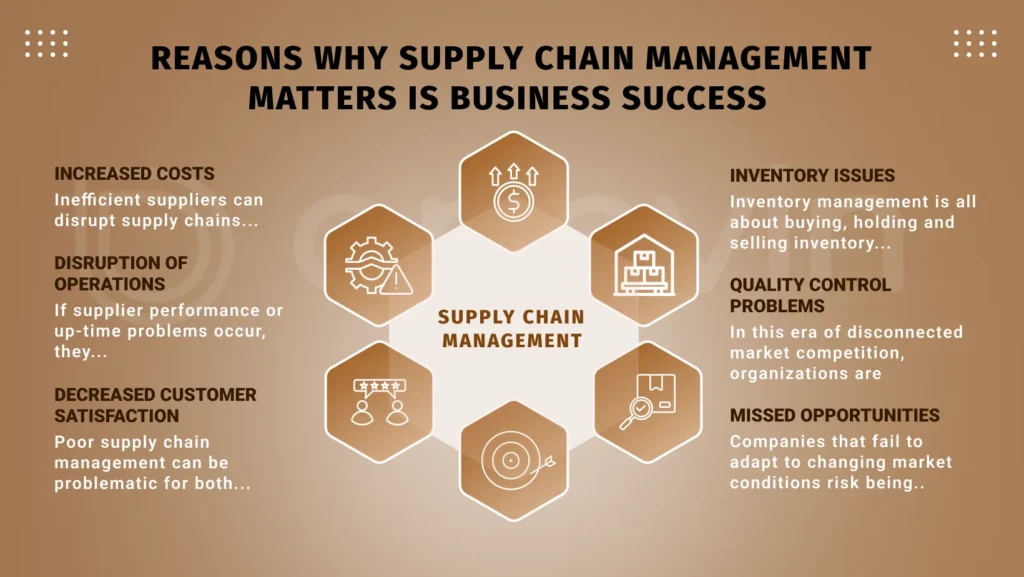Poor supply chain management poses several risks that have impacts on businesses across industries. From increased costs and disrupted operations to decreased customer satisfaction and inventory management issues, the consequences of supply chain failures are broad and deep inventory not being consumed inefficiencies, transportation delays, and manufacturing bottlenecks drive up costs, erode profitability and impede long-term planning. Furthermore, supply chain disruptions, whether due to natural disasters or supplier insolvencies, can lead to business outages, resulting in loss of revenue and damage to stakeholder relationships and broken lines. In today’s highly competitive marketplace, where customer experience is paramount, any mistake in delivery accuracy or product quality lowers customer satisfaction, and can lead to bankruptcy brand name
Finally, companies should recognize the critical importance of supply chain management in mitigating these risks and ensuring stability in times of uncertainty. In this article, we’ll explore poor supply chain management and the risks that arise due to poor supply chain management systems.
Reasons that Impact the poor supply chain management
Increased Costs
Inefficient suppliers can disrupt supply chains, leading to delays in production, increased lead times, and additional costs such as expedited shipping or tracking new products are offered. This can erode profitability and damage customer relationships. Nowadays, with the increase in consumption and productivity, companies want to cut costs to be competitive. In manufacturing companies, supply chain costs play an important role in the cost of the final product.
Disruption of Operations
If supplier performance or up-time problems occur, they can result in shortages of raw materials and specific products, affecting their availability in the broader market.
There are usually two sources of disruption in the supply chain – external and internal. There are limits to what can be done to avoid external violence. However, if the supply is damaged due to internal factors, it is within the company’s power to take reasonable steps to prevent such damage.
Decreased Customer Satisfaction
Poor supply chain management can be problematic for both business and customer relationships. The many issues manufacturers face, both internally and externally, can make supply chain management a complex task. Forbes magazine found that the number of customers worried about getting a deal has increased, with 30% more customers contacting customer support this year than last year. Poor customer service can also increase stress levels for both customers and employees, resulting in high levels of burnout. When the number of employees decreases, it puts more stress on other employees, making it more difficult to manage the supply chain. The lack of preparation and planning is likely to give competitors an advantage as customers switch suppliers, which could be a disaster in the long run.
Inventory Issues
Inventory management is all about buying, holding and selling inventory. Objects can mean anything from raw materials to final products. A mobile app for the supply chain can manage inventory or supply chain. However, in business, we manage the inventory. This means the right amount, in the right place, at the right time, and the right price. Furthermore, one of the most challenging tasks in managing the global supply chain is changes in demand. Demand may change at different times, due to changing practices, sales or supply, competition, or market fluctuations. Soliciting customers can be difficult. Too much or too little supply can cause big problems. Therefore, poor supply chain management may lead to an inventory issue.
Quality Control Problems
In this era of disconnected market competition, organizations are adopting new strategies to improve the quality standards of their products. Its main objective is to obtain a unique position in the minds of consumers. Modern businesses are customer-centric in approach. However, there is no doubt about this fact. If the brand does not satisfy the customers with the quality, it cannot have any impact on the customers.
For this reason, many organizations employ quality control experts. Currently, there is a growing need for a quality control approach to supply chain management.
Missed Opportunities
Companies that fail to adapt to changing market conditions risk being left behind. However, poor supply chain management can prevent a company from seizing new opportunities and adapting effectively. Whether it’s missed partnerships, product launch delays, or an inability to scale up production, the consequences of missed opportunities can be significant. In a world where innovation is the cash flow success, companies must be nimble enough to take advantage of emerging trends and market changes. Without measurement and monitoring, companies fail to identify opportunities to improve supplier efficiency or reduce costs. This hinders the possibility of supplier collaboration and flexibility.
Damage to Reputation
By overdue deadlines, companies risk damaging their reputation as reliable suppliers and subsequently damaging transparent relationships with customers is key to fulfilling the customer supply chain. Customers want customer service that is fast, informative and available when needed. Reputational risks often arise in the supply chain. More obvious factors, such as environmental degradation, excessive carbon emissions, or the risks of human rights violations, often cause these risks. Strategic decisions that include supply chains as part of a larger business plan can also pose a reputational risk. A comprehensive understanding of risk ensures that all activities are part of the risk assessment process. In an evolving regulatory environment, companies also face increasing regulatory requirements. The list goes on and deficient projects may face heavy fines and loss of operational and research costs, and the same may damage their reputation.
Conclusion
In conclusion, inadequate supply chain performance metrics and modelling can lead to problems in supply chain management, including increased costs, quality issues, and missed growth opportunities. Addressing these challenges requires companies to implement robust performance measurement systems, leverage technology and foster transparent communications with suppliers. By taking a proactive and data-driven approach, organizations can improve the quality of their supply chains, reduce risk, ensure supplier reliability, and finally, they have improved their competitiveness in the market.
FAQs
What are the common causes of supply chain disruptions?
Many things can mess up a supply chain. Natural disasters like floods, earthquakes, or hurricanes can ruin roads and buildings. This makes it hard to move goods. Things like political issues, trade fights, and world disagreements can also cause problems. They can make trade routes change and global markets unsure. Besides, other problems can occur with suppliers. They could go broke, have workers go on strike, or face quality issues. All these things can break the flow of items in the supply chain.
What are the key strategies for mitigating the risks of poor supply chain management?
Handling supply chain threats needs a many-sided strategy. Using high-tech tools such as artificial intelligence, blockchain, and future-focused data analysis can make your supply chain more Traceable, quick, and effective. Regular talks with suppliers, keeping an eye on their work, and evaluating risks can create stronger bonds and toughness. Spreading out your supply chain geographically and operationally can shrink reliance on a single source or area and soften the blow of sudden changes. Moreover, applying sound risk management methods, focusing on being green and ethical in sourcing, and promoting a mindset of ongoing betterment and adjustment are key to sturdy supply chains.
What steps can companies take to enhance supply chain resilience in the face of uncertainty?
Boosting the strength of a supply chain takes a hands-on approach to spotting and evaluating possible risks. This means doing routine checks to find weak spots in the chain. With this info, a plan can be crafted to tackle issues that might pop up. By tying up tight with suppliers and spreading out the resources, you can lessen dependence on one source or part. This adds pliability when it comes to fixing hitches.
How can companies improve inventory management to mitigate the risks of poor supply chain management?
Enhancing how we manage our stock needs better ways to predict demands, make purchases, and refill inventory. Using numbers and tools to plan ahead boosts our chances of hitting the target and helps us swiftly adjust to fluctuating demands. By utilizing swift storage methods and effective stock control methods, we ensure that goods are kept just enough to meet customer demand. It also reduces the likelihood of having too much stock. Moreover, fostering a cooperative relationship with our suppliers can provide clear and coordinated supply systems for all. It also minimizes the risk of overstocking.
How can poor supply chain management impact a company’s financial performance?
A weak supply chain management can affect a company’s budget in different ways. Boosted prices from handling inventory poorly, delayed transport, or bottlenecked production can cut into profits. Interruptions in the supply chain can result in fewer orders, contributing to lost earnings and extra costs to reduce the disruption’s impacts. Plus, sad customers and a hurt brand image can result in dwindling income over time, as customers go to rivals or quit buying from this company.







